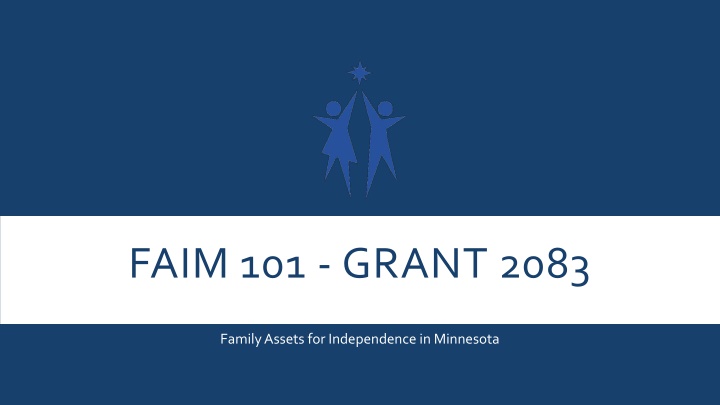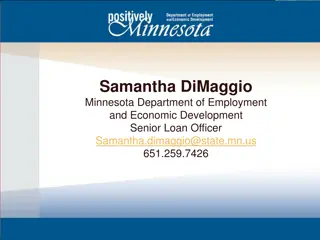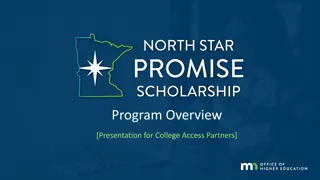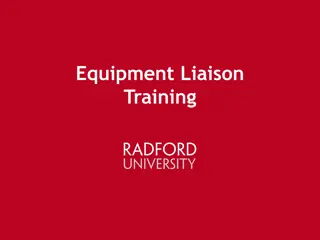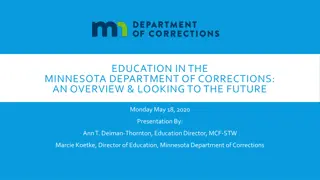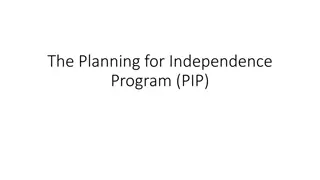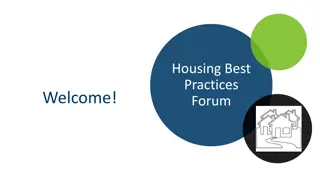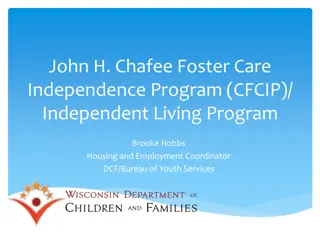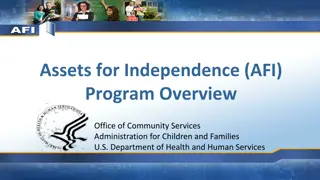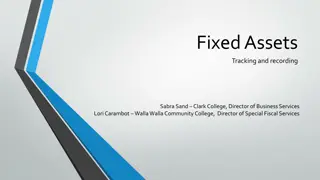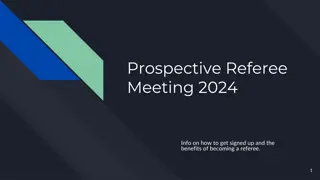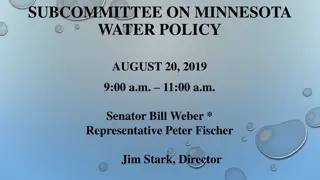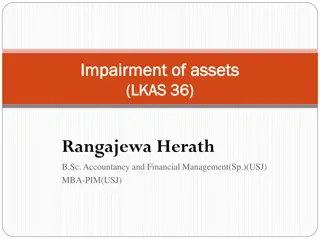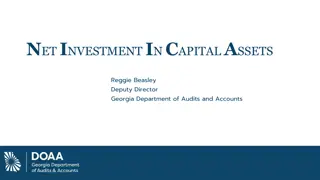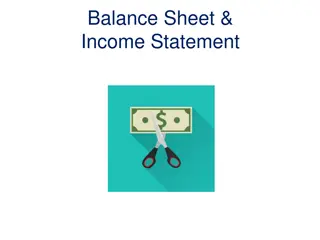Family Assets for Independence in Minnesota (FAIM) Program Overview
The Family Assets for Independence in Minnesota (FAIM) program helps individuals achieve financial independence through a structured process involving eligibility criteria, opening a savings account, financial coaching, obtaining assets, and closing the account. Eligibility requirements include income and asset limits, age criteria, residency, and citizenship status. Participants are required to make regular deposits into their FAIM savings account to reach their savings goals within a specified timeframe. Household income documentation is essential for determining eligibility.
Download Presentation

Please find below an Image/Link to download the presentation.
The content on the website is provided AS IS for your information and personal use only. It may not be sold, licensed, or shared on other websites without obtaining consent from the author.If you encounter any issues during the download, it is possible that the publisher has removed the file from their server.
You are allowed to download the files provided on this website for personal or commercial use, subject to the condition that they are used lawfully. All files are the property of their respective owners.
The content on the website is provided AS IS for your information and personal use only. It may not be sold, licensed, or shared on other websites without obtaining consent from the author.
E N D
Presentation Transcript
FAIM 101 - GRANT 2083 Family Assets for Independence in Minnesota
FIVE MAIN STEPS TO FAIM Eligibility Opening the Account Financial Coaching Obtaining the Asset (Payout Requests) Closing the Account
GENERAL ELIGIBILITY Timeline Must be able to obtain their chosen asset (in Minnesota) and exit the program within 30 months (2 years) of the first deposit made to their FAIM savings account. Income eligibility: Annual household gross income at or below 200% of current Federal Poverty Guideline Applicant must have earned income to use for deposits to their FAIM savings account. Asset eligibility Household net assets of $10,000 or less
SAVERS INCOME ELIGIBILITY Must be age 18+ or emancipated to sign the Contract Agreement. Must be a MN resident (through exit from the program) Must be a US citizen or eligible non-citizen Must have a valid MN driver s license or state-issued ID card Applicant must have earned income which is derived from: Traditional employment Self-employment Unemployment Worker s Compensation
SAVERS INCOME ELIGIBILITY Earned income must be enough to make the deposit into their FAIM account each month without being a burden to their budget. To build a habit of saving, the participant makes monthly deposits to their FAIM account until their goal is reached. The minimum requirement is quarterly deposits. Full account = $84/month for 24 months to save $2,000. Partial account = $42/month for 24 months to save $1,000. Previous household FAIM enrollments may affect the applicant s eligibility for match. Saver may vary monthly deposit amount, if needed, due to changes in income. Earned Income Tax Credit may be used to make lump sum or catch-up deposits. Deposits must be made to FAIM savings within 24 months of first deposit date, or they can t be matched no exceptions.
HOUSEHOLD INCOME ELIGIBILITY Household (HH): Anyone who lives and eats together Income from all sources (earned and unearned) is required from all adults (18+) in the household to determine the applicant s eligibility for FAIM. Total HH gross income at or below 200% of Federal Poverty Guideline Income documentation from all adults in the household is required: Federal 1040 from most recent tax filing year PREFERRED METHOD Or, most recent W2 s, AND documentation from all other sources (earned and unearned) Or, paystubs for 3 previous full months, AND from all other sources (earned and unearned) Award/benefit letters, letters for contractual pay, contracts, etc.
ASSET ELIGIBILITY - $10,000 OR LESS Excluded from assets: Primary home that the applicant lives in (if owned) One vehicle per household Any retirement or burial account with a penalty for early withdrawal. Take the net value of all remaining assets: Value of 2nd+ vehicle minus loan balance Checking and savings account balances minus current debts owed Business value (inventory, equipment, account balances, etc.) minus business loan balance No proof or documentation of assets is required
TIMELINE Program allows enrollee 30 months (2 years) to obtain their asset. Timeline starts on the day they make the first deposit to the FAIM savings account Have 24 months (2 years) to save and earn match. Have up to 6 additional months after saving period (if needed) to spend and exit. Things for the saver to consider: They may only choose one - which asset will they save for? Education student s timeline to attend college, grants/scholarships earned. Home Purchase credit score, debt load, cost of ownership Vehicle Purchase credit score, valid driver s license, insurance, tabs, cost of ownership Business Development start-up or expansion, asset requirements, how to use funds Do they have a difficult debt load? Does their budget support monthly deposits to FAIM savings without being a burden? Your agency s internal policies.
WEBSITE TOUR www.minnesotafaim.org Always use current forms that are posted on the FAIM website. Most forms were updated and made fillable since January 2021.
FIVE MAIN STEPS TO FAIM Eligibility Opening the Account Financial Coaching Obtaining the Asset (Payout Requests) Closing the Account
FAIMSAVINGS ACCOUNTS FAIM partners with Bremer Bank to host the client savings accounts and to provide weekly upload reports. FAIM accounts are set up as a Custodial Account at Bremer. The saver has no access to the account without authorization from the program. Their deposits earn interest from Bremer, but interest is not matched by FAIM. Program match funds are held by WCMCA in a separate escrow account. VistaShareis the database used by FAIM to track enrollment: www.1.vistashare.com The client IDA tab in VistaShareis a reflection of their FAIM savings account at Bremer Bank but with the program match added. Local coach (not Bremer) sends the participant a monthlyFAIM account statement that is pulled from VistaShare. FAIM Admin will notify when statements are ready each month. Unused client savings/interest will be returned to the client by Bremer Bank upon exit from FAIM, however, the match is forfeited back to the program.
FAIMSAVINGS ACCOUNTS Utilize the FAIM Account Opening Checklist!! Coach works with client to complete enrollment and account opening forms. Please note that Bremer Bank will not accept electronic signatures of coach or client on forms. FAIM Savings Account may be opened either: In person at a local Bremer Bank branch in Minnesota Make copies of forms for your local file. Client takes completed forms with them to the bank to open the FAIM account and make the first deposit. Be sure they bring their valid photo ID/driver s license along. We suggest they call ahead to see if an appointment is required. Electronically by sending the completed opening forms and copy of client ID to: depositservices@bremer.com The client must have an active smartphone and email account to open a FAIM account electronically. Bremer will send them a link to follow. Process must be completed within time allowed by Bremer or new link will have to be requested. Client needs to make the first deposit to their FAIM savings at Bremer Bank within 10 days. First deposit date triggers the start of their FAIM deposit and exit timelines.
OPENING FORMS For WCMCA FAIM application fully completed and signed/date by client with Local Agency Use boxes filled in. Income documentation Signed Contract Agreement and Beneficiary Form Signature Authorization for Withdrawals form Copy of valid MN driver s license or state-issued identification card Copy of applicant s current utility, cable, or internet bill with their name and service address listed For Bremer FAIM-Bremer Savings Account Opening Information Form FAIM-Bremer Release of Information Agreement FAIM-Bremer Certificate for Opening Asset Account Form FAIM -Signature Authorization for Withdrawals Form Copy of valid MN driver s license or state-issued identification card (with proof of address if different) Optional: Bremer Automatic Transfer Authorization Form
FIVE MAIN STEPS TO FAIM Eligibility Opening the Account Financial Coaching Obtaining the Asset (Payout Requests) Closing the Account
FINANCIAL EDUCATION Twelve (12) hours of Financial Education consists of: Successful completion of Financial Literacy course: FDIC Money Smart for Adults, Four Cornerstones of Financial Literacy, Common Cents One-on-one financial coaching with your client to establish/repair/build credit score. Ten (10) additional hours of Asset-specific Training consists of: Home Stretch or Framework Course with successful completion certificate Car Care/Buying Course with successful completion certificate Working with Small Business Development Center to create business plan and budget, taking business-related courses, talking to tax preparer, bank, about your business, etc. Career exploration activities, taking placement tests, working with college admissions, etc. One-on-one coaching
FIVE MAIN STEPS TO FAIM Eligibility Opening the Account Financial Coaching Obtaining the Asset (Payout Requests) Closing the Account
OBTAINING THE ASSET (PAYOUT REQUESTS) Utilize the Payout Request Checklist from the website!! Client should not wait until their final 30-60 days of enrollment to complete their requirements (or request final payout)! Client must complete minimum enrollment requirement of 6 months + 1 day from date of first deposit made to FAIM savings account. Client must have completed required training hours and asset requirements. Client must show there is an eligible expense when requesting a payout. Must allow 21 days for FAIM Admin to process the request. FAIM check must be made payable to a third-party vendor. Client must provide follow up documentation to show their asset was obtained.
PURCHASE EXAMPLES. Home Purchase Must show there is an eligible expense: Loan Estimate Must be to a third-party vendor: Title company, mortgage lender Must document that the asset has been purchased: Closing disclosure, copy of title/deed (if applicable) Education Purchase Must show there is an eligible expense: tuition statement with term charges/payments, class list with dates, credits, etc. listed, book receipts (if applicable) Must be to a third-party vendor: accredited post-secondary school (by statute) Must document that the asset has been purchased: final third-party bill from the school after drop/add date.
PURCHASE EXAMPLES Business Development Detailed business plan Projected monthly budget of income and expenses and itemized list for intended use of FAIM funds Business Plan Approval form signed by qualified reviewer Proof of current business account opened at an insured financial institution. EIN letter from IRS and W9 form Vehicle Purchase Must show there is an eligible expense: copy of signed Purchase Agreement (PA), title and lien release (if applicable), vehicle inspection, valid driver s license and insurance, book value of vehicle Must be paid to a third-party vendor: dealership or private seller Must document that the asset has been purchased: final copy of Purchase Agreement, title showing transfer to client only
MATCH MATH Always check the client s record in VistaSharefor their available savings/match balance. If client is not using their full savings/match, divide the total payout amount by 4. If it does not come out to an even cent, always round UP to the next cent. This is the CLIENT PORTION of the payout. This is also the amount you need to list on the Savings Transfer Request form for partial transfer. Subtract the client portion from the total payout amount. The difference is the MATCH PORTION that comes from WCMCA s escrow account. NOTE: the match amount can NEVER be more than 3x the client portion (not even by a penny).
VistaShare IDA Account Tab Account Balance: is the amount deposited in the FAIM account at Bremer Bank as of the last weekly bank upload generally completed on Tuesday afternoon. Match Balance: is the potential match funds earned on savings as of the last upload. Client MUST be enrolled for a minimum of 6 months + 1 day from first deposit date to be eligible for any match funds. Total Balance: is the current savings and match potentially available for payout if requirements have been completed.
FIVE MAIN STEPS TO FAIM Eligibility Opening the Account Financial Coaching Obtaining the Asset(Payout Requests) Closing the Account
CLOSING THE ACCOUNT Utilize the FAIM Exit - Account Closing Checklist from website!! If a payout was completed, provide any required follow up documentation to FAIM Admin (example: copy of final, signed Closing Disclosure) Exit form complete with the client and send to FAIM Admin. We strongly recommend working with the client on this form when they request their final payout (so you have leverage to get the information). Be sure to list their current asset/liability information for reporting purposes. Savings Account Closure form complete and send to FAIM Admin. The form is used to close the client s FAIM savings account at Bremer Bank. Be sure you list the client s current address if there are any funds remaining in the account, Bremer Bank will cut and mail a check to return the funds to the account holder at the address you provide on the form.
QUESTIONS??? suet@wcmca.org 218-685-7071 Sue Thoennes, FAIM Admin. Assistant kellim@wcmca.org 320-304-3458 Kelli Minnerath, FAIM Director
